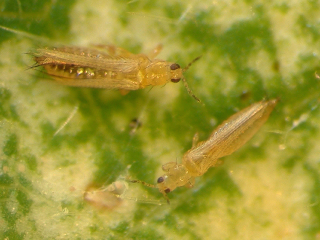Thrips species
Four economically important thrips species are found in stone and pome fruit in Western Australia:
- western flower thrips (Frankliniella occidentalis)
- tomato thrips (Frankliniella schultzei)
- onion thrips (Thrips tabaci)
- plague thrips (Thrips imaginis).
All species are found throughout Australia except for western flower thrips (WFT), which is not present in the Northern Territory. For stone fruit, plague thrips are more likely to be a problem at flowering.
For apples, plague thrips and WFT may both be present at flowering. Although all species can cause silvering damage, WFT is the most important.
Thrips damage has been recorded from Gingin, the Perth Hills and Donnybrook/Manjimup.
Identification
Thrips are very difficult to identify without the aid of a microscope. If in doubt of an identification, send the specimens into DAFWA. The correct identification of WFT is most important, as it has developed resistance to a range of insecticides commonly used in orchards.
Sources of thrips
Surveys of orchards in the Perth Hills show that clover, plantain, fat hen, flatweed, capeweed and wireweed host the highest numbers of WFT. These weeds were most common in orchards and most likely to survive harsh summer conditions. WFT and other thrips can also be found in other species.
Plague thrips are a native species and can breed on native plants, particularly acacia (wattle) and eucalypts. They can be carried long distances on the wind.
Monitoring
- Start monitoring from budburst. Early in the season monitor by tapping buds and flowers into an icecream container. Most thrips found in August/September are likely to be plague thrips, with plague and WFT occurring later in the season (November-March).
- Blue sticky traps can also be used. As a rough guide, place five traps per hectare. Traps should be hung in the lower third of the tree and checked weekly.
- The addition of thrips lures such as Lurem and Thripline can further increase trap capture of WFT. Lurem will also increase capture of onion and plague thrips.
- As there appears to be no correlation between damage and the number of thrips caught on traps, direct inspections of flowers and fruit are still required.
- When trap catches indicate that thrips are present at critical periods (flowering/shuck fall, ripening), directly sample for thrips adults and their larvae.
Control
Weed control
- As weeds act as reservoirs for thrips, their management is essential. Thrips are particularly attracted to flowering weeds as they feed on the pollen.
- Be careful if you spray weeds with herbicide. As the weeds die off, thrips can move off the weeds onto your crop. You may want to treat weeds with insecticide at the same time.
- Mowing is another control option, though weeds in the drip line may escape control.
Biological control
- No biological controls are currently available for thrips control in orchards.
- Generalist predators such as lacewing and ladybird larvae may feed on thrips larvae.
Chemical control
- See the APVMA website for current recommendations.
- Chemical control of WFT can be problematic due to insecticide resistance. Correct identification of WFT is recommended for this reason.

